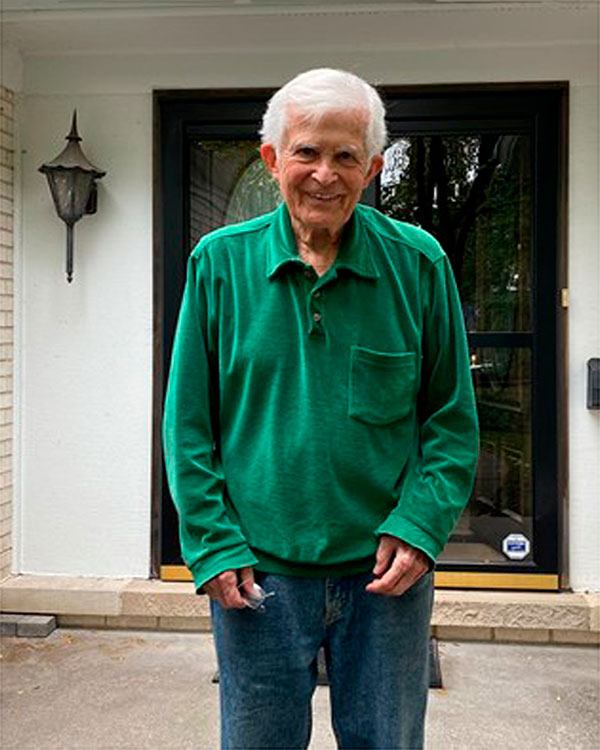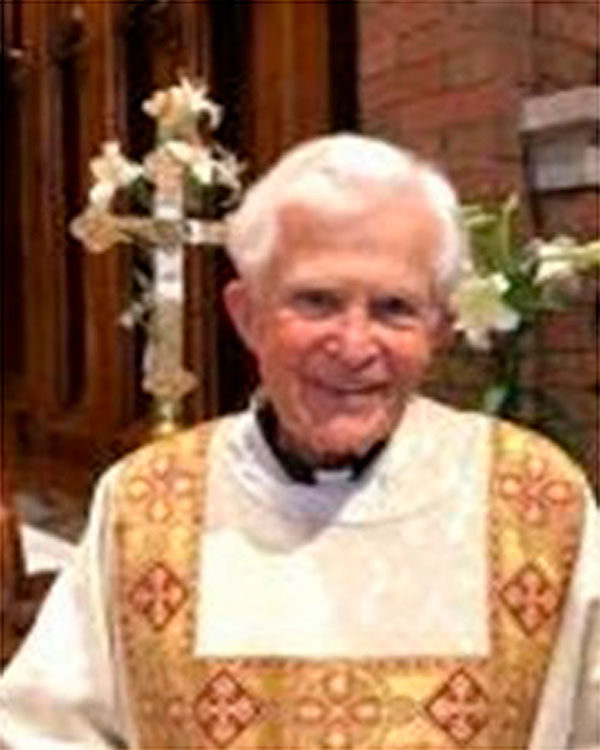U.S. Navy World War II Park Ridge, IL Flight date: 10/27/21
By Wendy L. Ellis, Honor Flight Chicago Veteran Interview Volunteer
David Grauer didn’t set foot on the deck of a destroyer until three months before the end of World War II. Although he feels badly that he never saw combat, he is also very glad he never had to kill anybody. For the 94 year old retired dentist and Episcopal deacon, those mixed emotions color his feelings about going on this final Honor Flight trip of 2021. He just doesn’t feel he deserves it. He couldn’t be more wrong.
It was an odd sort of early birthday present that landed him in the U.S. Navy just months before he was to graduate from Lakeview High School. “I came down from my bedroom the day before I turned 18, and my father said, ‘You’re going to join the Navy today. You are not going into the Army.’ I asked why and he said ‘Because you’ll get killed David!’” David’s parents knew they were still fighting in Europe and once he turned 18 he could be drafted into the Army almost immediately. “I remember saying, I’m supposed to be in school today and he said, ‘Don’t worry about that. Mom will call up.’”
Thus ended his career as a high school student and his stint in the U.S. Navy began. It was March of 1945, and by the time he finished Basic Training at Glenview Naval Air Station, and was shipped to the West Coast for deployment, two more months had passed. He was assigned to the USS Stephen Potter (DD-538), a Fletcher-class destroyer. David spent three days in Gunnery School, and then headed out to patrol the west coastline of the United States and accompany carriers to and from Hawaii. He was assigned to a 40 mm cannon, and during the day he took care of a 5-inch gun turret, but he never fired it.
“I never pulled the trigger,” says Grauer, “but I know where I slept…the bottom, the third bunk up. I’d turn over and OW!, I’d hit the ceiling.” Although he never saw combat, he knows the USS Stephen Potter was in any number of conflicts from Iwo Jima to Okinawa. The ship is credited with fishing many a downed pilot or sailor from the ocean, stories he heard often from the older sailors on board.
“Even then, I thought about shooting down a plane to protect the people on the ship. I thought to myself, I’d be killing somebody. That bothered me. I must admit that bothered me. But I’d do it if I had to do it. But to kill somebody who was raised in a different country. Here I am and there he is, and that bothered me a lot.” In a way, he was glad he never had to make the choice so many others had made before him.


When the Navy decommissioned the USS Stephen Potter, Grauer was one of the last men off. He was discharged a few months later and headed home. He went to Northwestern University on the GI Bill and chose dental school over medical school because so many GI’s were doing the same thing; getting into dental school was a quicker option. During his college years, he spent summers working at Children’s Memorial Hospital, where a pretty young woman worked in the same unit. “She was gorgeous!” says Grauer. “One of the guys I worked with bet me a couple bucks that I couldn’t get a date with her, so I asked her out. She said ‘Pfltttt!’ that means no!” He forgot about it, but a few months later she found him and said, “I hear you like to dance.” That comment and the Aragon Ballroom led to their wedding at the end of his third year in dental school.
While his wife Joan taught at Evanston High School, he finished dental school and set up shop in the Pickwick Theater building in downtown Park Ridge. It was a building he remembered well from his childhood, passing it every summer as his family traveled from Cincinnati to Wisconsin. It was the start of an illustrious career that included learning some of the newest dental techniques and practices at a yearly visit to the Pankey Institute in Florida. It was the early 1960’s and all sorts of new ideas were happening in the field of dentistry. “It taught you how to be the very best dentist possible,” says David. Dr. Grauer’s book, The TMJ Healing Plan is used in many dental schools and by dentists everywhere who treat temporomandibular joint syndrome.
And intertwined through all of these years is the Rev. Dr. Grauer’s commitment to the Episcopal Church. Ordained as a deacon in 1979, the Rev. Dr. Grauer has been able to use his skills to help people pro bono from many corners of the world. In the 1980s, the church brought several young men from war torn Sudan to the United States. Known as the Lost Boys of Sudan, Dr. Grauer treated all of them with no expectation of anything in return. The Bishop of southeast Mexico has been a patient at times, along with others from that part of the country. Although he retired in February of this year, a month before he turned 94, he still helps people through his church, St. Mary’s Episcopal in Park Ridge.
Joan Grauer died 5 years ago, sadly, the day before David Grauer’s 90th birthday. He laughs about it now. “I’ll never forget it. She said, ‘David you’re going to be 90 pretty soon.’ I think she just didn’t want to be married to a 90 year old man!”
“I am a person who’s learned to live alone. I’m near my parish. I still do deacon callings. I read a lot. Only thing is when you’re alone you watch television too much,” says Rev. Dr. Grauer. “Old age, at my age, is so different. It’s lonely, but I have some wonderful friends I would miss if I moved.”
Thank you for your service, Rev. Dr. David Grauer, not just in the military but also in your lifelong commitment to helping others. Enjoy your well-deserved Honor Flight to Washington D.C.


